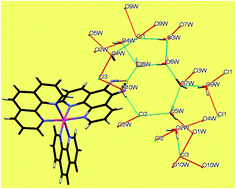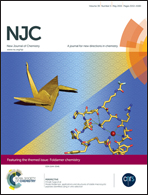Supramolecular architecture and photophysical and biological properties of ruthenium(ii) polypyridyl complexes†
Abstract
Complexes of the type [Ru(N–N)2(tdzp)]Cl2, where N–N is 2,2′-bipyridine (bpy) (1), 1,10-phenathroline (phen) (2), dipyrido[3,2-d:2′,3-f] quinoxaline (dpq) (3), which incorporate the [1,2,5]-thiadiazolo-[3,4-f]-[1,10]-phenanthroline (tdzp) ligand, have been synthesized and characterized by IR, 1H-NMR, 13C-NMR, ESI-MS, elemental analysis, UV-Visible and luminescence spectroscopy. The molecular structure of complex 2 is confirmed by single crystal X-ray structure determination. A two-dimensional cyclic water–chloride anionic {[(H2O)10(Cl)2]2−}n network has been structurally identified in a hydrophobic matrix of 2. Interaction of these complexes with Calf Thymus DNA (CT-DNA) was explored by electronic absorption and emission spectroscopy and circular dichroism spectroscopy. The nucleolytic cleavage activity of complexes 1–3 has been carried out on double stranded circular plasmid pBR322 DNA by gel electrophoresis experiments. The cytotoxicity of the complexes against a cancer cell line has been studied by MTT assay and cellular localization of complexes within the cells has been monitored by fluorescence microscopy. Notably, 1–3 exhibit potent antiproliferative activities against a panel of human cancer cell line.


 Please wait while we load your content...
Please wait while we load your content...